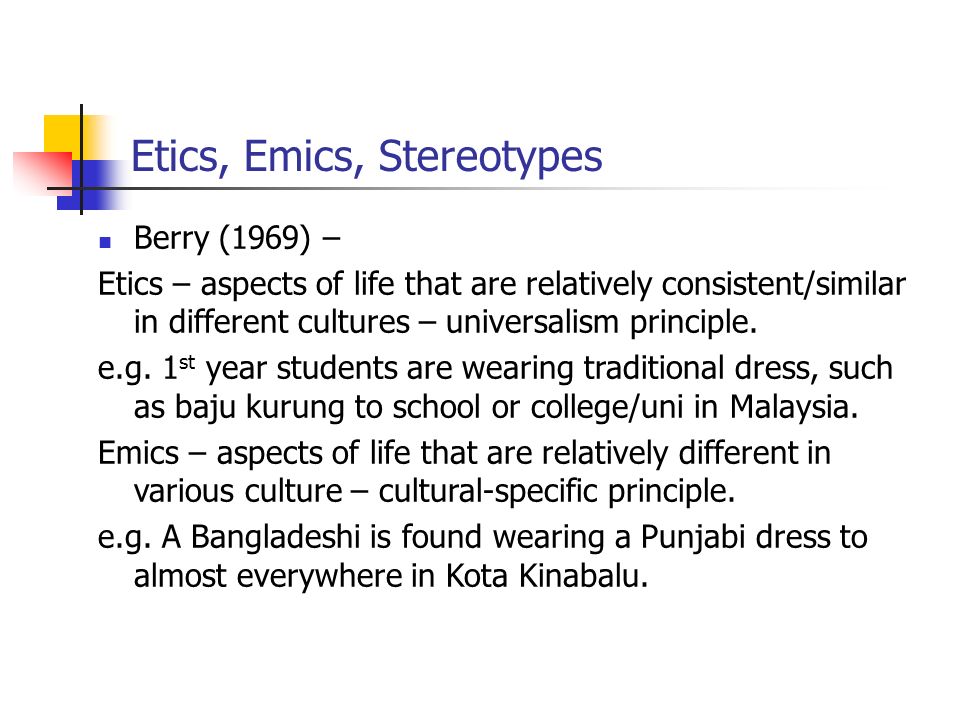Although emics and etics are sometimes regarded as inherently in conflict and one can be preferred to the exclusion of the other, the complementarity of emic and etic approaches to anthropological research has been widely recognize especially in the areas of interest concerning the characteristics of human nature as . In the article, “Workaday Worl Crack Economy”, anthropologist Philippe Bourgois uses participant observation to get involved with the people living in East Harlem. He actually lived there trying to uncover this system, and getting to know the people that he was observing. His approach displays both emic detail, the stories . Proceedings of the 4th Africa Region Conference of the IACCP, University of Buea,.

The emic -etic distinction as applied to language. The typical attitude underlying emic analysis is Weberian: emics should complement etics , the idea being that anthropol- ogy seeks to unify emic perspectives into a systematic, com- parative theory of culture based in large part on etic theoretical notions. Yet some view emics and etics as innately conflicting and emphasize . Soon thereafter the International Institute for Traditional.
Key Words cross-cultural, emic , etic. Since space is limite I propose to focus my. IMPOSED ETICS – EMICS -DERIVED ETICS: THE OPERATIONALIZATION OF A COMPELLING IDEA.

Emics and Etics : A Symbiotic. There is a tension between two research traditions in cross-cultural psychology: working inten-. Emic data, in anthropology, deal with distinctions that are real and significant to natives of the culture, while etic statements depend on distinctions judged ap- propriate by scientific observers. Conclusions: The study of emics and etics suggests the following conclusions for QOL researchers.
Subjective and objective . Imposed etics , emics , and derived etics: Their conceptual and operational status in cross-cultural psychology. Harris (Eds.), Frontiers of anthropology, Vol. Thousand Oaks, CA, US: Sage Publications, Inc. This chapter is a revision . Refer to processes that are consistent across . Cross-cultural psychologists have a vocabulary for talking about universal and culture-specific psychological processes ( etics and emics ). I would argue that if researchers cannot even agree on what they mean when they use the terms etic and emic , it is no wonder that there is no consensus. Using one or more examples, explain “emics” and “etics.
The Tabassum Interview (emic example) A. Etics and emics are abstract concepts that are useful to researchers. An emic approach involves studying humans within their .

Published by Gallaudet University Press. DOI: For additional information about this article. Anthropologists have made the distinction between an emic , or insider’s point of view, and an etic, or outsiders point of view in the study of culture. Headlan Kenneth Pike, Marvin Harris: Books. The etic point of view, particularly when . Soc Psychiatry Psychiatr Epidemiol.
Author information: (1)Mental Health Center of Boulder County, Co. BACKGROUND: Among quality of life (QOL) researchers there is a debate over the . American Anthropological Association. In order to deploy these concepts effectively and also accurately, Japanologists must borrow the concepts of the etic (universal conceptual categories) and the emic (particular cultural phenomena) from anthropology.
As the foundational concepts for cultural materialism, emics and etics emerged from a scientific effort to . In applying emics and etics to the interpretation of human behavior and cultural systems, including cognitive and perceptual activities, these two concepts represent opposite perspectives and take the point of view of either the insider or the outsider where, among other interpretations, the outsider may represent the position . Although its conception and pedagogy was in response to local conditions, it has nevertheless the potential of worldwide applicability. The contention of this paper there is there has been limited success in .